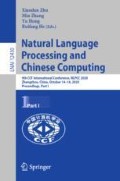Abstract
Stance detection aims at identifying the stance (favor, against or neutral) of a text towards a specific target of opinion. Recently, there is a growing interest in using neural models for stance detection, but there are still some challenges to be solved. Firstly, it is difficult to associate text with target because targets are not always discussed explicitly in texts. However, existing methods always roughly model the representations of text and target on task-specific and limited corpus without considering the indispensable external information. Secondly, different from categories in normal classification task, we find that stances in stance detection task are not independent to each other. We study this observation and find it would be more effective to learn each stance individually. But all previous approaches ignore the correlation. To address these two challenges effectively, we introduce a Stance-wise Convolution Network (SCN) including two novel modules. Specifically, we first use a Text-Target Encoder module to subtly incorporate the pre-trained BERT into our model to learn more reasonable text-target representations. Then we propose a Stance-wise Convolution module to better learn stances by absorbing the correlation between stances. We evaluate our method on real-world dataset and the experimental results show that our proposed method achieves the state-of-the-art performance.
D. Yang and Q. Wu—Contribute equally.
Access this chapter
Tax calculation will be finalised at checkout
Purchases are for personal use only
References
Augenstein, I., Rocktäschel, T., Vlachos, A., Bontcheva, K.: Stance detection with bidirectional conditional encoding. arXiv preprint arXiv:1606.05464 (2016)
Cho, K., et al.: Learning phrase representations using RNN encoder-decoder for statistical machine translation. arXiv preprint arXiv:1406.1078 (2014)
Devlin, J., Chang, M.W., Lee, K., Toutanova, K.: BERT: pre-training of deep bidirectional transformers for language understanding. arXiv preprint arXiv:1810.04805 (2018)
Dey, K., Shrivastava, R., Kaushik, S.: Topical stance detection for twitter: a two-phase LSTM model using attention. In: Pasi, G., Piwowarski, B., Azzopardi, L., Hanbury, A. (eds.) ECIR 2018. LNCS, vol. 10772, pp. 529–536. Springer, Cham (2018). https://doi.org/10.1007/978-3-319-76941-7_40
Du, J., Xu, R., He, Y., Gui, L.: Stance classification with target-specific neural attention networks. In: International Joint Conferences on Artificial Intelligence (2017)
Howard, J., Ruder, S.: Universal language model fine-tuning for text classification. arXiv preprint arXiv:1801.06146 (2018)
Kim, Y.: Convolutional neural networks for sentence classification. arXiv preprint arXiv:1408.5882 (2014)
Kingma, D.P., Ba, J.: Adam: a method for stochastic optimization. arXiv preprint arXiv:1412.6980 (2014)
Mohammad, S., Kiritchenko, S., Sobhani, P., Zhu, X., Cherry, C.: Semeval-2016 task 6: detecting stance in tweets. In: Proceedings of the 10th International Workshop on Semantic Evaluation (SemEval-2016), pp. 31–41 (2016)
Pang, B., Lee, L., et al.: Opinion mining and sentiment analysis. Found. Trends® Inf. Retrieval 2(1–2), 1–135 (2008)
Peters, M.E., et al.: Deep contextualized word representations. arXiv preprint arXiv:1802.05365 (2018)
Radford, A., Narasimhan, K., Salimans, T., Sutskever, I.: Improving language understanding by generative pre-training (2018). https://s3-us-west-2.amazonaws.com/openai-assets/researchcovers/languageunsupervised/languageunderstandingpaper.pdf
Radford, A., Wu, J., Child, R., Luan, D., Amodei, D., Sutskever, I.: Language models are unsupervised multitask learners. OpenAI Blog 1(8), 9 (2019)
Siddiqua, U.A., Chy, A.N., Aono, M.: Tweet stance detection using an attention based neural ensemble model. In: Proceedings of the 2019 Conference of the North American Chapter of the Association for Computational Linguistics: Human Language Technologies, Volume 1 (Long and Short Papers), pp. 1868–1873 (2019)
Sobhani, P., Mohammad, S., Kiritchenko, S.: Detecting stance in tweets and analyzing its interaction with sentiment. In: Proceedings of the Fifth Joint Conference on Lexical and Computational Semantics, pp. 159–169 (2016)
Vaswani, A., et al.: Attention is all you need. In: Advances in Neural Information Processing Systems, pp. 5998–6008 (2017)
Wei, P., Mao, W., Zeng, D.: A target-guided neural memory model for stance detection in twitter. In: 2018 International Joint Conference on Neural Networks (IJCNN), pp. 1–8. IEEE (2018)
Wei, W., Zhang, X., Liu, X., Chen, W., Wang, T.: pkudblab at SemEval-2016 task 6: a specific convolutional neural network system for effective stance detection. In: Proceedings of the 10th International Workshop on Semantic Evaluation (SemEval-2016), pp. 384–388 (2016)
Yang, Z., Dai, Z., Yang, Y., Carbonell, J., Salakhutdinov, R., Le, Q.V.: Xlnet: generalized autoregressive pretraining for language understanding. arXiv preprint arXiv:1906.08237 (2019)
Zarrella, G., Marsh, A.: Mitre at semeval-2016 task 6: transfer learning for stance detection. arXiv preprint arXiv:1606.03784 (2016)
Zhou, Y., Cristea, A.I., Shi, L.: Connecting targets to tweets: semantic attention-based model for target-specific stance detection. In: Bouguettaya, A., et al. (eds.) WISE 2017. LNCS, vol. 10569, pp. 18–32. Springer, Cham (2017). https://doi.org/10.1007/978-3-319-68783-4_2
Acknowledgements
This work is supported by State Grid Technical Project (No. 52110418002W).
Author information
Authors and Affiliations
Corresponding author
Editor information
Editors and Affiliations
Rights and permissions
Copyright information
© 2020 Springer Nature Switzerland AG
About this paper
Cite this paper
Yang, D. et al. (2020). Stance Detection with Stance-Wise Convolution Network. In: Zhu, X., Zhang, M., Hong, Y., He, R. (eds) Natural Language Processing and Chinese Computing. NLPCC 2020. Lecture Notes in Computer Science(), vol 12430. Springer, Cham. https://doi.org/10.1007/978-3-030-60450-9_44
Download citation
DOI: https://doi.org/10.1007/978-3-030-60450-9_44
Published:
Publisher Name: Springer, Cham
Print ISBN: 978-3-030-60449-3
Online ISBN: 978-3-030-60450-9
eBook Packages: Computer ScienceComputer Science (R0)


